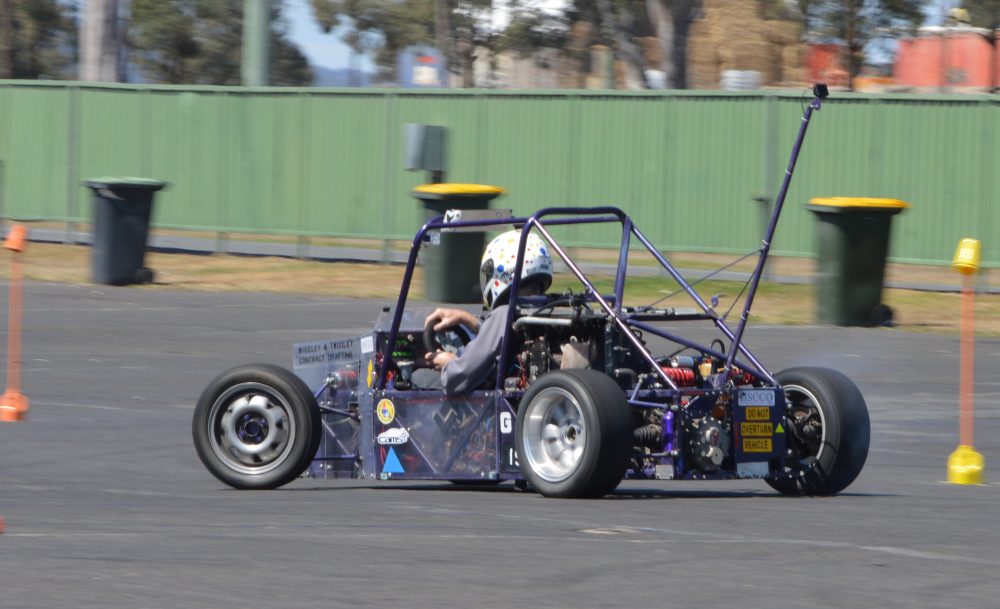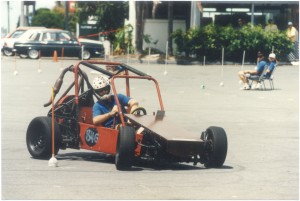RADENKERBTIER MOTORKHANA SPECIAL.
Brisbane, Queensland, Australia.
Radenkerbtier was the fourth motorkhana special built by Alan Wheeley. The name came from two German words because it was made mainly from Volkswagen parts. “Rad” is wheel in German; and “Kerbtier” is buggy in German. Therefore “Wheel’s Buggy” became Radenkerbtier. It was built to replace another car that had design deficiencies that could not be overcome.
Independant rear suspension was deemed to be better than the previous swing axle setup, so the rear suspension from a VW Station Wagen was purchased from Langdon’s Wreckers, together with a Superbug gearbox, and a ball joint front end out of a VW 1500 Type 1. This front end had big disc brakes for better stopping, and 4 stud hubs for the newer wheels. Unfortunately the front end is designed for a lot more weight that you get in a motorkhana car, so the top tube was cut in two places, and a Meyers Manx “Select-A-Drop” welded in place.
The actual rolling chassis was welded up on Sunday 22-10-1978, and an alloy framed steering wheel fabricated in July 1979. Tho old motor out of Alan’s VW Beetle was taken apart and rebuilt with 86 mm barrels and pistons, then bolted to the chassis on 10th August.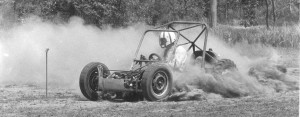
It had its debut on the IWMAC Purga dirt grounds on 12th August, 1979, but the brake pedal mounts broke off. Completely new pedals were manufactured for it, and new wheel bearings fitted before towing it to the Australian Motorkhana Championships in Adelaide on the 26th August. It then competed in the motorkhana part of the Toowoomba Carnival of Flowers in the main street, in the rain. Construction of a special purpose trailer for the car was started in October, 1979 and first used for towing it to Surfers Paradise for the Speed Week Motorkhana on Thursday night 1st November. The car had its first outing at the Echo Valley Dirt Hillclimb in Toowoomba on 11th November. The car was weighed in this trim and came in at 430 kilograms, with 17% of that on the front wheels.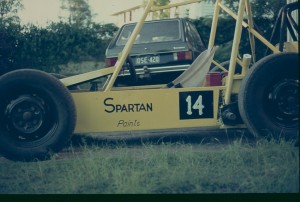
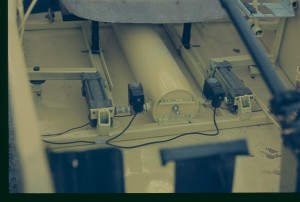
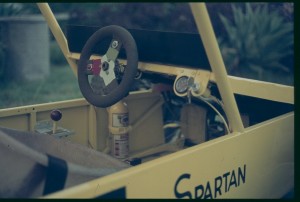
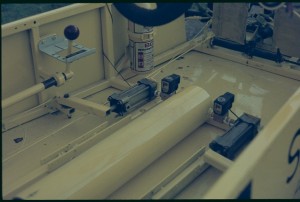
An innovative air operated turning brake mechanism was built in February, 1980. The sizing of the cylinders was wrong, so larger cylinders were obtained and fitted. The whole car was taken to Denis Hall of Spartan Paints in March 1980, and painted in Spartan Ultrathane in brilliant yellow. The trailer was painted in equipment enamel. Signwriting was done by the owner to thank those firms that had helped with equipment used on the car. A new “Scat” over the top exhaust system with megaphone trumpet tailpipe was fitted for the first run at Mt Cotton Hillclimb on 16th March, 1980, and it sounded wonderful. However the air operated turning brakes still did not work well enough, so they were replaced with normal hand operated cable brakes. The car was towed one thousand miles north to Townsville for the second round of the Queensland Championships where it won outright. The next weekend it was at Rockhampton to run in the Round 3 on the grass, where it placed second. Around this time a SAAB 900 was taken to Surfers Paradise to try to beat the 24 hour record, and lots of Pirelli P6 tyres were supplied for the attempt. However the Saab chewed these tyres to shreds on the abrasive surface, and they were thrown on the tyre scrapheap. Alan found the 4 best of these, and fitted them to some 6″ wide rims to use on the bitumen, and made an enormous difference to the handling. In July 1980, the car ran at a club day at Sutfers Paradise, where the high speed handling was tested to the limit. Then it was taken to the first IWMAC Autocross held at Coominya, on a tight sandy circuit. Lots of high powered desert racers turned up to be trounced by Radenkerbtier because it was better suited to the track. however, a month later when the next Autocross was held, the steering box came loose on the front of the car with a high speed excursion at the finish line resulting. Keeper plates were welded on to stop that happening again. A hot dog muffler was fitted to the flange joint in the exhaust to quieten the noise for events where there were restrictions.
It was towed to Melbourne for the Australian Motorkhana Championships in August 1980, where it scored second in class, but the trailer succumbed to problems on the way home. The wider wheels and extra components had now increased the weight to 470 kilograms when weighed in October, 1980. The high speed handling was again tested when it was taken to Lakeside Circuit in November, 1980.
In February 1981, the air cooled VW motor was taken off and a Mazda Rotary motor installed, with an RX2 radiator mounted at the front to try to counteract the motor weight. However when it was tried out at Lakeside, the front wheels would instantly launch into the air on application of power, and the steering did not work with the front wheels off the ground. Rotary motors may be small, but they are very heavy. A bearing in the motor siezed, so the VW motor was replaced.
It was towed to Townsville in April where it again won outright. The following Saturday it ran on the bitumen at Rockhampton, and then on the dirt on Sunday to record third outright. The next weekend was a demonstration event at the Boonah Show, and a cow cockie looked at the radiator mounted (still) on the front, and the VW motor on the back, and believed the story that this was one of the new water cooled VW motors.
 In May 1981 it was towed back to Rockhampton for the Motorkhana School, where it won outright, then down to Coffs Harbour in NSW for thr State Of Origin motorkhana where it again triumphed. A month later it did it again at Ipswich, but then the bubble burst at the QMROA round of the Championships where it was a victim of some bastardry between the Clerk of Course and the Scrutineers and declared illegal. All of the major chassis tubes had been built from 25 x 3 square tube, and these sections were used in the bracing between the front and rear roll hoops, and the cross bracing to the rear of the chassis. The CAMS regulations had been changed to outlaw non circular sections in any roll bars. It was argued that if the bars between the front hoop and the rear hoop were cut off, then the car would then become legal, but very dangerous, but the scrutineers held firm. Rules are rules, regardless of whether they are stupid. The car then had the square section braces cut out, and replaced with circular section of less strength, but it was back being legal.
In May 1981 it was towed back to Rockhampton for the Motorkhana School, where it won outright, then down to Coffs Harbour in NSW for thr State Of Origin motorkhana where it again triumphed. A month later it did it again at Ipswich, but then the bubble burst at the QMROA round of the Championships where it was a victim of some bastardry between the Clerk of Course and the Scrutineers and declared illegal. All of the major chassis tubes had been built from 25 x 3 square tube, and these sections were used in the bracing between the front and rear roll hoops, and the cross bracing to the rear of the chassis. The CAMS regulations had been changed to outlaw non circular sections in any roll bars. It was argued that if the bars between the front hoop and the rear hoop were cut off, then the car would then become legal, but very dangerous, but the scrutineers held firm. Rules are rules, regardless of whether they are stupid. The car then had the square section braces cut out, and replaced with circular section of less strength, but it was back being legal.
Around this time Tony Poulos ran his Alfa Romeo at the Surfers 12 Hour Sports Car Race, and the Dunlop slicks he used were still in good nick after the event. A deal was struck to “borrow” them for Radenkerbtier for bitumen events in return for giving Tony a co-drive in the car. However the car did not give him the thrill he expected, but the slicks were kept for motorkhanas on bitumen. It was towed to Canberra for the Australian Motorkhana Championships in August where it scored fastest time in the Lazy Eight test, but a motor stalling problem saw it end up in 4th in class. Driver errors at the Surfers Paradise Speedweek Motorkhana caused a poor performance, but at Toowoomba the next month it was fastest outright.
1982 started well with another first outright at Ipswich, and then it was taken to the porsche Motorkhana School at Kooralbyn in March. A poorly timed front-end throw at Townsville in April resulted in second outright, and the following weekend in Rockhampton it was third outright.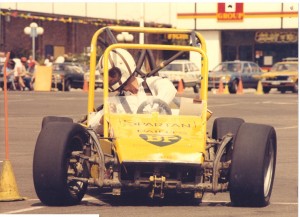
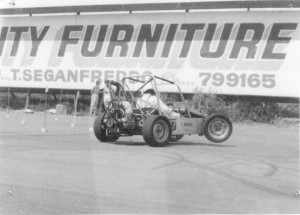 The Australian Motorkhana Championships were held in Brisbane in 1982, and the car won its class in that event. But the seeds of a radical new design were sown on that weekend, and the car was sold to Malcolm Ryan in December 1982. Malcolm towed it with him when he shifted to Melbourne on 1st January, 1983. He ran it at the AMC in Melbourne in September, and started on overhaul after the event. He towed it back to Brisbane in 1984, but suffered a major road accident when towing it to Nambour to get the motor rebuilt. It was not until April 1985 that the car ran again, and it had only two outings in that year. It was taken to Coffs Harbour in 1986 for the State of Origin Motorkhana where Alan Wheeley (the previous owner) won outright. The car was then left on the trailer in Malcolm’s yard while he had some family troubles until September 1990 when Alan Wheeley organised to take over the car, and start to fix 4 years of erosion. In April 1991 the car was taken to Steve Sheehan for him to work on in a deal where both he and Alan would drive it in events. Alan’s radical new car had been banned, and he had nothing to drive. Steve did a freshen up of the motor in June 1991, and repainted the car in August of that year. Both drove it in 1992 and 1993 before Alan started work on his new car designed to the new regulations. Steve built a “Killer” VW engine for the car in 1994, but it detonated. He built another in 1995 with the same result. Both drove the car in occasional events in the following years. Ownership of the car was given to Steve Sheehan on 8th December, 2001 and it ran occasionally in 2003 and following years. Unfortunately it has not been driven since 2008, and is stored in Steve’s shed.
The Australian Motorkhana Championships were held in Brisbane in 1982, and the car won its class in that event. But the seeds of a radical new design were sown on that weekend, and the car was sold to Malcolm Ryan in December 1982. Malcolm towed it with him when he shifted to Melbourne on 1st January, 1983. He ran it at the AMC in Melbourne in September, and started on overhaul after the event. He towed it back to Brisbane in 1984, but suffered a major road accident when towing it to Nambour to get the motor rebuilt. It was not until April 1985 that the car ran again, and it had only two outings in that year. It was taken to Coffs Harbour in 1986 for the State of Origin Motorkhana where Alan Wheeley (the previous owner) won outright. The car was then left on the trailer in Malcolm’s yard while he had some family troubles until September 1990 when Alan Wheeley organised to take over the car, and start to fix 4 years of erosion. In April 1991 the car was taken to Steve Sheehan for him to work on in a deal where both he and Alan would drive it in events. Alan’s radical new car had been banned, and he had nothing to drive. Steve did a freshen up of the motor in June 1991, and repainted the car in August of that year. Both drove it in 1992 and 1993 before Alan started work on his new car designed to the new regulations. Steve built a “Killer” VW engine for the car in 1994, but it detonated. He built another in 1995 with the same result. Both drove the car in occasional events in the following years. Ownership of the car was given to Steve Sheehan on 8th December, 2001 and it ran occasionally in 2003 and following years. Unfortunately it has not been driven since 2008, and is stored in Steve’s shed.
In November 2013, Geoff Johnson took over ownership of the car after his similar car was stolen from his home garage. He is in the middle of a complete rebuild of the car, and hopes to be competing in it in 2014.
